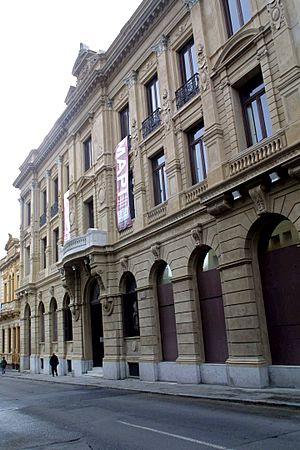Museum of Pre-Columbian and Indigenous Art facts for kids

Building façade
|
|
| Established | September 17, 2004 |
|---|---|
| Location | Montevideo, Uruguay |
| Type | Ethnographic museum |
The Museum of Pre-Columbian and Indigenous Art (also known as MAPI) is a cool museum in Montevideo, Uruguay. It's located in the old part of the city, called Ciudad Vieja. This museum is special because it focuses on the amazing cultures of people who lived in Latin America long ago, even before Christopher Columbus arrived. It also celebrates the indigenous people who live there today. An ethnographic museum like MAPI shows the cultures of different groups of people.
Contents
History of the Museum Building
The building where the museum is located has a long history! It was designed in the late 1800s by Emilio Reus and two German architects. They first planned it as a special medical center using water treatments.
The building was finished in 1888. Many years later, in 1986, it was recognized as a National Historic Monument. This means it's an important historical place. For a while, it was used by Uruguay's Ministry of National Defense. After some time, the building was left empty.
In 2004, the building was fixed up and the Museum of Pre-Columbian and Indigenous Art officially opened. In 2013, the museum joined the Google Arts & Culture platform. This means you can explore some of its collections online from anywhere!
Exploring the Museum's Collections
The museum has more than 700 items on display. These exhibits teach us about different cultures and ancient discoveries. MAPI mainly focuses on the indigenous people of Uruguay. But it also has many cool things from other parts of Latin America.
Cultures of Mesoamerica
One section explores the Mesoamerica region. This area includes countries like Mexico and Guatemala. You can learn about the ancient civilizations that thrived there.
Cultures of the Intermediate Region
Another part of the museum covers the intermediate region. This includes countries such as Colombia and Ecuador. Here, you can see items from cultures like Cuasmal, Capulí, and Tuncahuán.
Cultures of the Andean Region
The museum also features the Andean Region. This area includes Peru and the western part of Bolivia. You can discover the rich history of the people who lived in the Andes Mountains. There's also a section for the South Andean region, which includes Chile and a small part of Argentina.
Types of Exhibits
Among the many things you can see at the museum are textiles, which are woven fabrics. There are also traditional musical instruments, ancient ceramics, and beautiful art. The museum also has special exhibits about the indigenous people from the Amazon rainforest and the Plata River basin.
See also
 In Spanish: Museo de Arte Precolombino e Indígena para niños
In Spanish: Museo de Arte Precolombino e Indígena para niños

